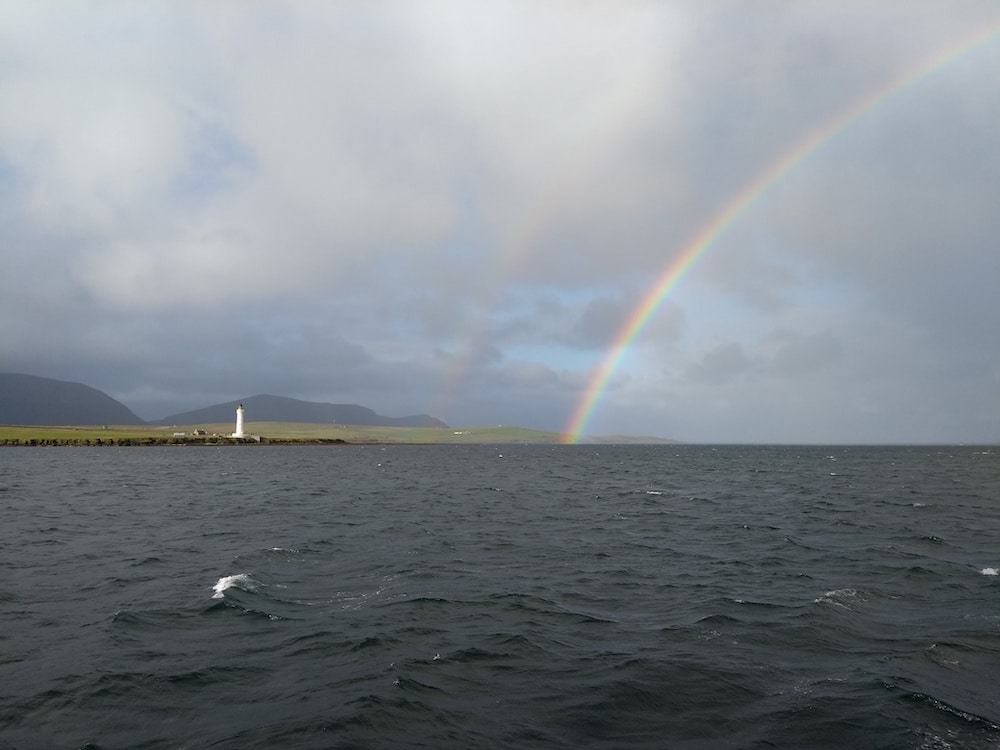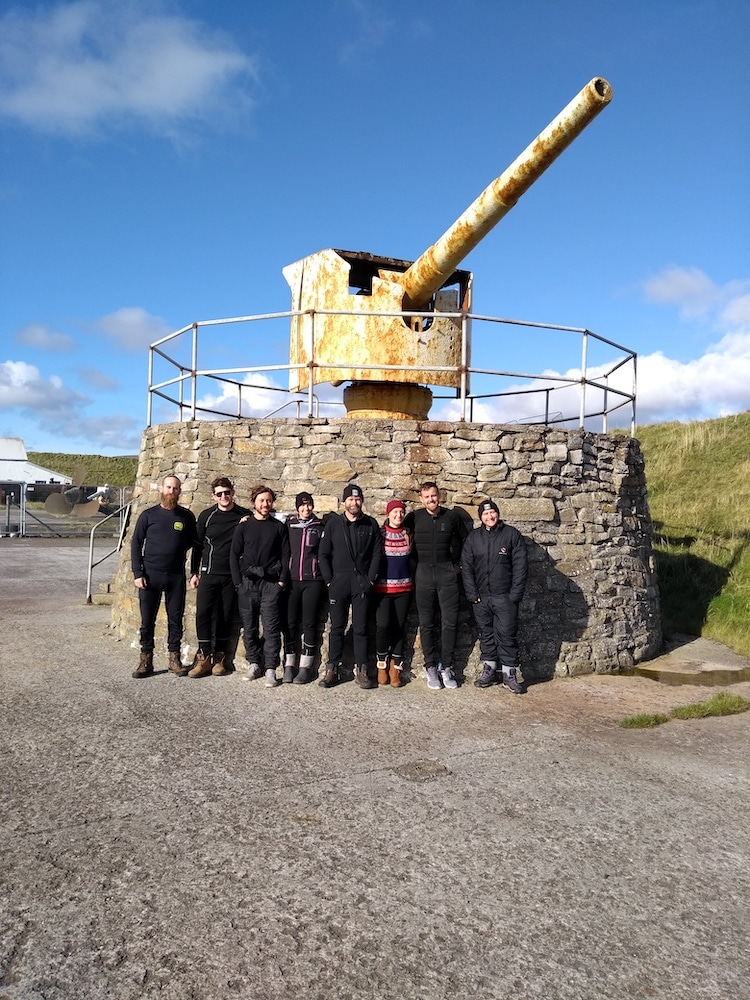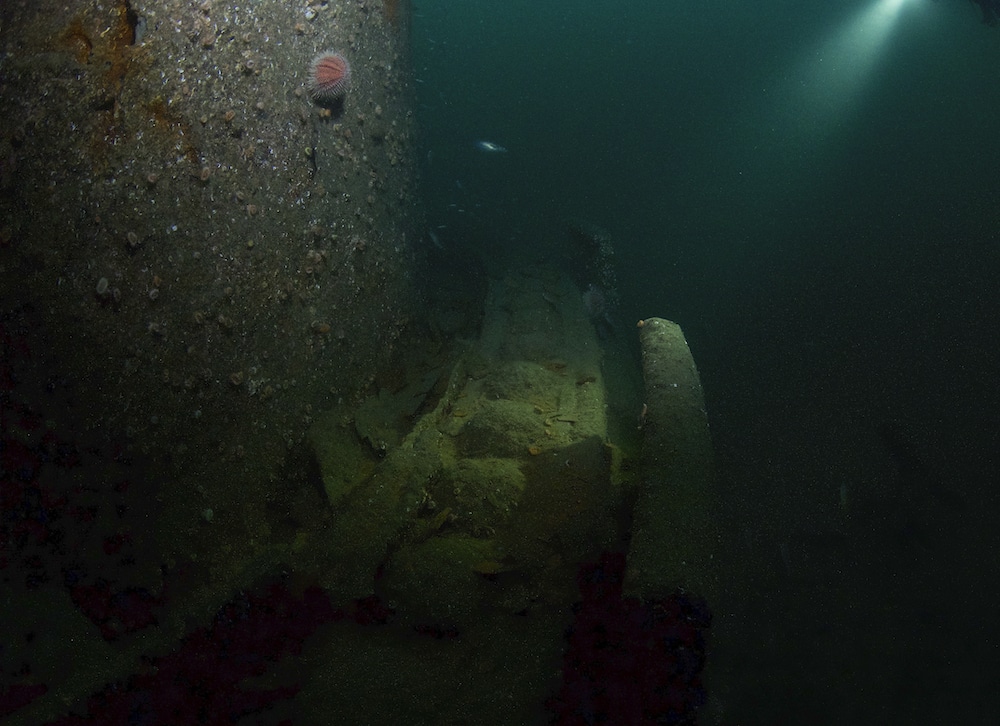News
Return to Scapa Flow: Beyond the Battleships

We had the opportunity to return to Scapa Flow this fall, during the centenary year of the scuttling of the German Fleet. As always it was with great excitement that we arrived in Stromness, added to that we were diving on a boat filled with our dive friends from around the world. With the reunion and high experience level of the boat, it was certain to be a fun week!

The Dream Team
The itinerary for the week included the usual celebrities, the König, Karlsruhe, Kronprinz Wilhelm, Brummer, Cöln and F2 as well as some rather special dives including the Markgraf. Following the centenary commemorations many of the German High Seas Fleet vessels have had flags placed on the wrecks, which gave an interesting new feature to search out in additon to the metal structures and marine life.

Stromness
The massive German battleships and cruisers are rightfully the stars of the Flow and for our technical divers the collosal bow of the Markgraf was the experience of the week… but we found that there are some interesting additional options if you have the time and crew to take you to different dive sites. We were fortunate enough to dive three wrecks that we hadn’t before: the sunken U-Boat UB-116, the Bayern turrets, and the blockship Tabarka.

Our Dive Boat
UB-116
The UB-116 was the last U-Boat to be sunk in WWI. On October of 1918, with the aim of penetrating Scapa Flow and detroying as many vessels as possible, UB-116 unknowingly entered the minefield protecting Hoxa Sound and was destroyed. She was raised in 1919, but foundered at the mouth of Pan Hope. A controlled explosion was conducted to deal with the live torpedoes, and as such the submarine is very broken up with the conning tower as one of the few remaining identifiable features.

The wreck of UB-116 is pretty small, and relatively shallow for Scapa Flow, so it is usually done as a second dive of the day. We enjoyed our short drop into the site as it was something different to see. The detached conning tower lying about 10 meters from the rest of the hull was still intact and a delight to swim around. The rest of the hull was mostly tangled metal wreckage but we managed to see a nice dogfish swimming around the wreckage. Plus now we can say we have dived a submarine!
Bayern Turrets
The battleship SMS Bayern was interned in Scapa Flow with the German High Seas Fleet and scuttled on 21st June 1919. During salvaging in 1934, the extraordinarily heavy armored turrets of the Bayern slipped out of their hull and remain upside down on the ocean floor to this day. They now sit at a max depth of 45m.

Our dive on the Bayern turrets dive site offered a look at something special: the insides of the 15-inch guns of the battleship Bayern. At 38m, our bottom time was limited, but we were still able to circle and get good looks at two of the mighty turrets. The highlight was seeing the tracks of 10-inch steel ball bearings on which the turrets used to rotate. This was quite a unique dive and had us wishing for more dive time.
Tabarka
The Tabarka was originally sunk as blockship in Kirk Sound in 1941, but was raised and re-sunk as a blockship in Burra Sound in 1944. She is now one of the 3 remaining blockships in the flowing current of the Burra Sound, resting upside down at 15m, she is only divable at slack tide.
The wreck of the block ship Tabarka was a surprise favorite of ours as the best dive of our week in Scapa. In this area of extreme tides, not only do you need an experienced skipper to drop you in at the right place, but you need to do a negative entry to get down to the wreck as quickly as possible. One upside of the current here is that it means there are less suspended particles in the water and better visibility than at other spots in the Flow and also the tidal currents nourish the marine life that clings to the wreck.
Our dive group managed to get straight down to the bottom (it wasn’t deep, maybe 12m or so), and then fin right up to the side of the Tabarka. The wreck was roughly split in two halves, and each side offered not only respite from the current, but an ethereal, almost zen-like atmosphere with sunlight streaming in through windows and cutouts in the hull, along with strands of kelp wafting in the current. The floor and inside of the wreck was festooned with life and we had ample time to slowly explore each half of the wreck, enjoying the experience for around 45 minutes. The return to our boat was a dramatic conclusion to the dive, with a carefully coordinated fast drift in the current as we ascended slowly. Those with a keen eye spotted the remains of other blockship wrecks below us as we drifted. Back on board it was clear from all the grinning faces that we were not the only ones totally enthralled by this wreck.

One final note … underwater photography in Scapa Flow is hard! To my chagrin it took me 7 dives to figure out that a standard fisheye lens with two strobe setup doesn’t really cut it there, given the average visibility was about 4 meters. The solution: as many thousands of lumens of off-camera lighting as you can manage. A team of lighting assistants would also be rather helpful! Volunteers anyone? The best I could manage on this trip were a few grainy black and white conversions, but at least I’ll know better before our next visit!

Follow more of CJ and Mike’s diving adventures at www.bimbleintheblue.com.
News
UWACAM Impresses at BOOT 2025 with New App

BOOT 2025, the world’s largest water sports trade fair, provided the perfect stage for the launch of the new UWACAM app which meanwhile is rated at an excellent 4.8 out of 5 in the Apple App Store.
Optimized for DIVEVOLK (divevolkdiving.com) Seatouch housings and developed in collaboration with award-winning underwater filmmaker Matthias Lebo (matthiaslebo.com), this app is user-friendly and features large, clear controls, enabling effortless and stunning shots.
It offers professional functions typically found in high-end cameras, supports the LOG format for advanced color corrections, includes built-in LUTs (Color Lookup Tables) to restore underwater colors, and provides a manual mode, user presets, histogram, focus peaking, zebra function, and much more.
As an official product of Bumbayaya GmbH (bumbayaya.ch / uwacam.com), the UWACAM app has been specifically designed for use in DIVEVOLK Seatouch underwater housings. Visitors were able to experience the app live at the DIVEVOLK booth.
UWACAM simplifies underwater photography with an intuitive user interface that is perfectly adapted for underwater operation. The app offers precise control and delivers impressive results for both hobby divers and professionals.

Why UWACAM?
- Specifically developed for DIVEVOLK: Perfect integration into Seatouch housings for effortless underwater operation.
- Simple yet professional: Switch between an Easy Automatic Mode for beginners and a comprehensive Pro Mode.
- All-in-one app: Supports all photo and video formats, including LOG for professional color corrections.
- Pro Features:
- Focus Peaking: Precise focus control.
- Zebra Function: Prevents over- or underexposure.
- Built-in LUTs: Color corrections for realistic underwater shots.
- Manual Controls: Fine-tune exposure, focus, white balance, and more.
- Diver-Specific Features: Automatic color correction based on environment and dive depth, plus an optional magnetic compass overlay.
“We are excited to present UWACAM at BOOT 2025,” says Matthias Lebo, who played a key role in its development. “With UWACAM, we bring the beauty of the underwater world directly into the hands of divers and snorkelers—intuitive, powerful, and adaptable.”
Customer Reviews


Available in the App Store
UWACAM is now available for download in the App Store.
https://apps.apple.com/de/app/uwacam/id6714463099
News
Gear Review: Atomic Blade Fins (Watch Video)

In a video produced exclusively for Scubaverse.com, Jeff Goodman reviews the Blade Fins from Atomic Aquatics.
For more information about products from Atomic Aquatics, visit www.atomicaquatics.com.
Sea & Sea is the home of Atomic Aquatics and other leading diving brands in the UK.
-

 Gear Reviews2 months ago
Gear Reviews2 months agoGear Review: SurfEars 4
-

 Marine Life & Conservation2 months ago
Marine Life & Conservation2 months agoPaul Watson Released as Denmark Blocks Japan’s Extradition Bid
-

 News1 week ago
News1 week agoHumpback Mother and Calf Win Underwater Photographer of the Year 2025
-

 Blogs3 months ago
Blogs3 months agoJeff Goodman Launches Underwater Moviemaker Course with NovoScuba
-

 News2 months ago
News2 months ago2-for-1 tickets now available for GO Diving Show
-

 News3 months ago
News3 months agoDive into Adventure: Limited Space Available for January Socorro Liveaboard Trip with Oyster Diving
-

 News2 weeks ago
News2 weeks agoGo Diving Show 2025 Exhibitor Showcase
-

 News3 weeks ago
News3 weeks agoFilming 360 in The Bahamas















![Visit Roots Red Sea in Hall 2, Stand 680 at this weekend's Go Diving Show to get the Full Monty!
Roots Red Sea's Full Monty Special Package consists of the following:
7 Nights at Roots Red Sea in Deluxe Chalet with Soft All Inclusive – Meet & Greet Airside [no visa available at £25 per person] with Return Airport Transfers – 1 Day House Reef with Orientation, 3 Days 6 Shore Dives, 2 Days 2 RIB Dives. £885 per person sharing. In Booked before the 31st March 2025 and travel before 1st September 2025. Minimum 2 pax.
Discover more Go Diving Show special offers in Scubaverse's Go Diving Show 2025 Exhibitor Showcase here:
https://www.scubaverse.com/go-diving-show-2025-exhibitor-showcase/
#scuba #diving #dive #diveshow #godivingshow #trip #travel #holiday #vacation #redsea #egypt #special #offer #package #deal](https://www.scubaverse.com/wp-content/plugins/instagram-feed/img/placeholder.png)